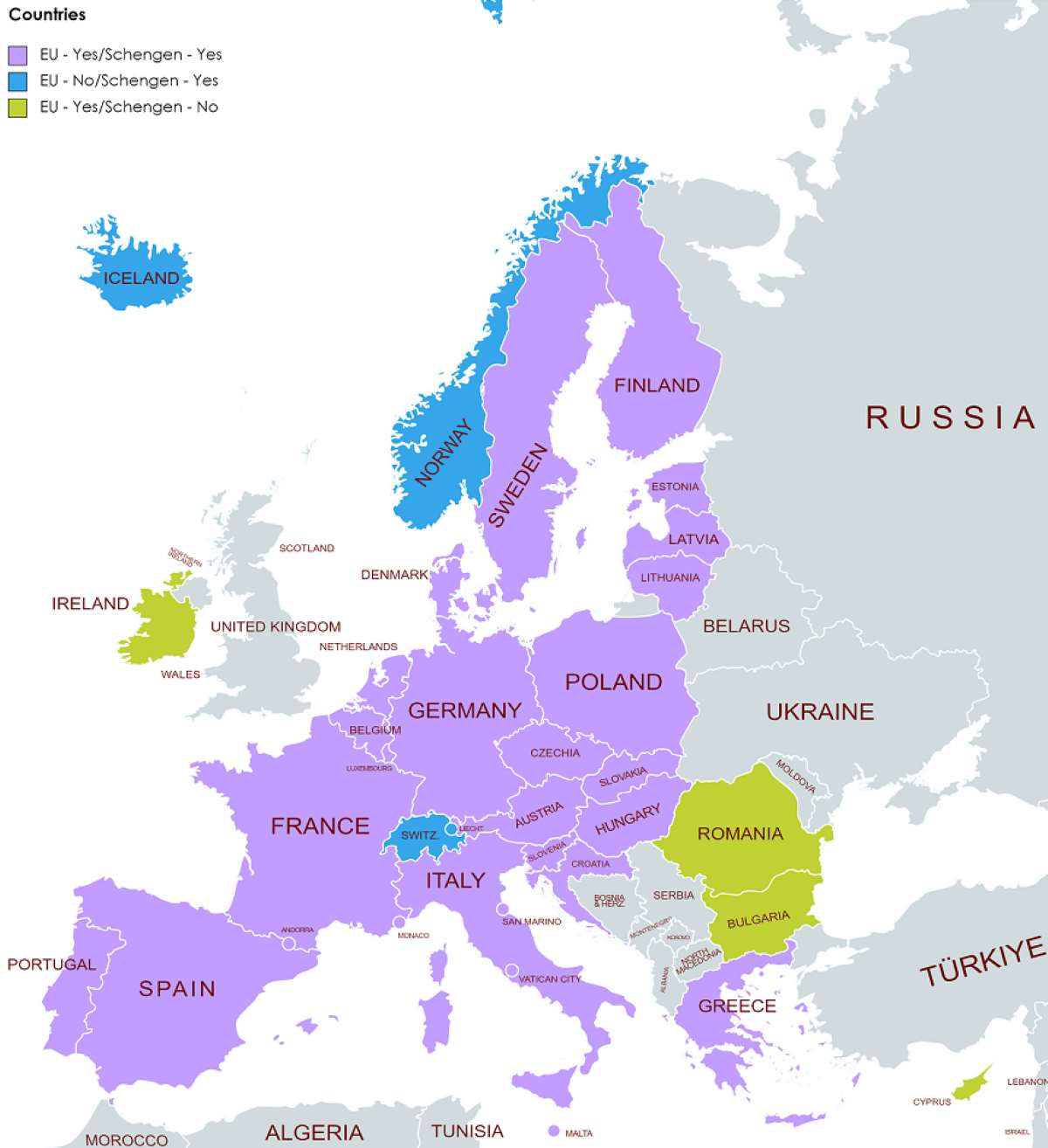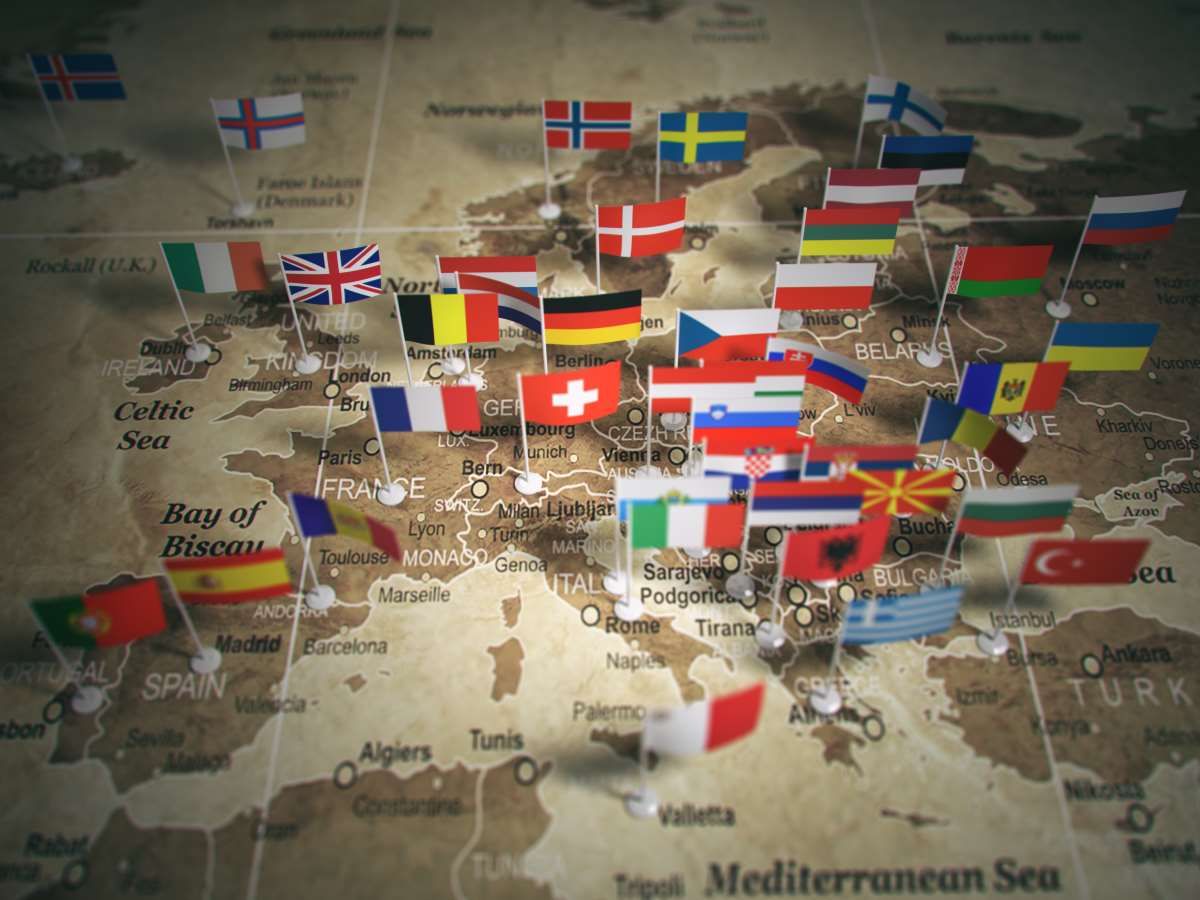
Premium starting ₹395
100% Claims Settled (FY 24-25)


Premium starting ₹395
100% Claims Settled (FY 24-25)


As of January 2025, the Schengen zone comprises 29 European countries, allowing passport-free movement for its citizens and visitors with valid visas within the zone. Croatia became the 27th country to join the Schengen area on 1st January 2023. Romania and Bulgaria are the latest addition to the list of Schengen countries.
According to the Schengen agreement, citizens of all Schengen countries can liberally cross internal borders within the Schengen zone without any checks.
If you are planning a trip to any Schengen country, understanding the Schengen Area and its visa requirements is crucial. Explore the complete list of Schengen countries, understand what the Schengen zone is and the essentials of a Schengen visa.

Here’s the complete list of countries that fall under the Schengen zone.
The Schengen Area was named after a village in Luxembourg, ‘Schengen’, which is located on the border with Germany and France, where the agreement was signed in 1985. The Schengen region encompasses 29 European countries that have officially abolished border controls at their mutual borders.
The Schengen Zone functions largely as a single jurisdiction with a common visa policy, allowing for visa-free movement for its 400 million citizens and visitors with valid permits.
In Europe, EU refers to the European Union, a political and economic union of 27 member states. Non-EU simply refers to all the other European countries that are not members of the European Union.
While most Schengen member countries are part of the European Union (EU), four are from the non-European Union (EU):
There are five European countries that remain outside the Schengen Area:
Indian nationals need a Schengen Visa to travel to the European countries falling under the Schengen zone for short stays, studies, or business purposes for up to 90 days in any 180-day period. They also need a Schengen visa if they require to pass through a Schengen airport's international transit area.
Countries must meet a specific criterion to join the Schengen Area, and this process can be lengthy. Here are the countries that are expected to join the Schengen zone:
Note: It’s important to note that these are the current expectations, and the actual accession may depend on various factors. For the most accurate and up-to-date information, it’s recommended to check the official EU website or respective country’s websites.
The Schengen Area offers a visa-free zone for travel across many European countries. Here's what Indian travellers need to know:
The process typically includes identifying the relevant embassy or consulate based on your entry point or planned stay duration, researching their specific visa application requirements, submitting the application along with the necessary fees, and attending an appointment with the application centre.

Austria, which is bordered by 8 countries, is located in Central Europe. It is a landlocked country with 8.9 million inhabitants in Central Europe. This country signed the Schengen agreement on 28th April 1995.
Portugal, which falls in the Schengen Zone, shares borderlands with Spain. It has a population of around 10.1 million (approx.) residents. It signed the Schengen agreement on 25th June 1991.
It is located in Western and Central Europe, with Poland and the Czech Republic bordering the east and Denmark in the north. This Central European country borders nine nations. Germany has a population of 84 million people. It signed the Schengen agreement on 14th June 1985.
The Czech Republic is one of the European Schengen countries. This landlocked country is bordered by Germany, Poland, Slovakia and Austria. It has a population of approximately 10.7 million as of 2016. It signed the Schengen agreement on 16th April 2003.
Poland is located in Central Europe. It is home to nearly 37.8 million residents. It signed the Schengen agreement on 16th April 2003.
Italy is a part of Schengen countries, located in the heart of the Mediterranean Sea. It is bordered by Switzerland, France, Slovenia, Austria, the Vatican City and San Marino. Nearly 60.2 million people reside in Italy. It signed this agreement on 27 November 1990.
Luxembourg has a population of 650,847 residents. It signed the Schengen agreement on 14th June 1985.
Estonia, a country in northeastern Europe, is bordered by 3 Baltic states. Latvia surrounds it in its south, the Baltic Sea in its west, Lake Peipus and Russia in the east and the Gulf of Finland to the north. It is home to nearly 1.3 million residents. The Estonian government signed the Schengen agreement on 16th April 2003.
Latvia shares borders with Lithuania in the south, Estonia in the northern region, Russia in the east and Belarus in the southeast. It has a population of nearly 1.8 million people. It signed the Schengen agreement on 16th April 2003.
Part of the Schengen countries, Spain shares borders with France in the north and the Bay of Biscay. It has a population of 46.7 million residents. Spain signed the agreement on 25th June 1991.
Lithuania shares a border with Poland to the south, Latvia to its north, Belarus to the east and south, and Kaliningrad Oblast in the southwest. It has a population of 2.9 million residents. Lithuania signed the Schengen agreement on 16 April 2003.
Finland is located in northern Europe and is home to nearly 5.5 million residents. Sweden borders it to the northwest, Norway to the north and Russia to the east. It signed the Schengen agreement on 19th December 1996.
Iceland is located in the North Atlantic. It has a population of nearly 376,248 people. It first signed the Schengen agreement on 19th December 1996, followed by a second agreement on 18th May 1999.
Italy borders Austria to the north, Slovenia to the west, Croatia to the southeast and Hungary to the northeast. It has a population of 2 million. The country signed the Schengen agreement on 16th April 2003.
Slovakia is a landlocked country in Central Europe and is home to nearly 5.5 million residents. It shares borders with Ukraine in its east, Poland in the north, the Czech Republic to its west, Austria in the southwest and Hungary in its south. Slovakia signed this Schengen agreement on 16 April 2003.
Denmark occupies the peninsula of Jutland, which extends northward from the centre of continental Western Europe. Nearly 5.8 million people live in Denmark. It signed the Schengen agreement on 19th December 1996.
Hungary is a part of the list of Schengen countries. It is located in Central Europe and is home to nearly 9.6 million residents. Serbia surrounds it in the south, Slovakia in the north, Romania in the east and Slovenia in the west. It signed this Schengen agreement on 16th April 2003.
Malta consists of an archipelago in the Mediterranean Sea. It has a population of 444,409 residents. Malta signed this Schengen agreement on 16th April 2003.
Switzerland is landlocked between France in the west, Italy in the south, Austria and Liechtenstein in the east and Germany in the north. It signed this Schengen agreement on 26 October 2004.
Belgium is a low-lying country in Western Europe. It is bordered by the Netherlands, France, Luxembourg and Germany. Moreover, Belgium is a federal state divided into three regions francophone Wallonia, Dutch-speaking Flanders and Brussels. Belgium signed the Schengen agreement on 14th June 1985.
France is located on the western edge of Europe. The English Channel surrounds the country in the northwest, the Bay of Biscay in the west, the North Sea in the north and the English Channel in the northwest. It has a nearly 65.6 million population. It signed the Schengen agreement on 14th June 1985.
Liechtenstein is a doubly landlocked microstate in Central Europe. It has a population of 38,395 residents. Liechtenstein signed a Schengen association agreement with the European Union on 28th February 2008.
Greece falls under the Schengen country name list. It is located at crossroads of Asia, Europe, and Africa. It is home to nearly 10.2 million residents. Greece signed the Schengen agreement on 6th November 1992.
Norway is surrounded by Skagerrak strait in its south, Finland and Russia in its northeast and Denmark on another side. Nearly 5.5 million people reside in this country. It signed the Schengen agreement on 19th December 1996, followed by a second agreement on 18th May 1999.
Sweden is located in Northern Europe. It shares borders with Finland and Norway. It is home to nearly 10.2 million residents. Sweden signed this agreement on 9th December 1996.
Netherlands borders Belgium to its south, Germany to its east, and the North Sea to its northwest. It has nearly 17 million residents. Netherlands signed the Schengen agreement on 14th June 1985.
Now let us check the advantages a Schengen visa holder can experience on his/her travel.
Situated in Southeast Europe, Croatia is bordered by Slovenia and Hungary to the north, Serbia, Bosnia and Herzegovina to the east, Montenegro to the south and the Adriatic Sea separating Italy from Croatia to the west. A little over 4 million people populate the country. Croatia signed the Schengen agreement on 1st January 2023, becoming the 27th member of the Schengen Area.
Romania, one of the largest countries in Europe is the latest full member of Schengen area. People from India now can visit the breathtaking places of Romania along with other Schengen countries with a Schengen visa.
Bulgaria joined the Schengen area as a full member in January 2025. With mesmerizing tourist destinations, this country offers a mix of Eastern and Western culture.
Read More